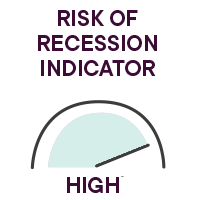Yann Furic
B.B.A., M. Sc., CFA®
Senior Portfolio Manager, Asset Allocation and Alternative Strategies
A volatile month and a positive quarter
For stock markets around the world, September unfolded under two major themes. Each has enabled certain sectors to benefit from the current situation, which remains completely outside the norm.
Telework and the economic recovery
- Telework has generated increased income in certain consumer sectors. Online shopping for a wide variety of consumer goods, which is becoming a lasting trend among consumers, along with the use of a growing diversity of technology products have benefited both large cap stocks and big tech issues. This explains the generally strong performance of the Nasdaq Index, which is highly concentrated in technology.
- As for the economic recovery, it has boosted job creation and led to increased income for individuals and businesses. As a result, so-called more cyclical stocks such as banks, industrials, basic materials and energy rallied.
Winners and losers
Much uncertainty remains. The second wave of the COVID-19 pandemic and the return to certain lockdown measures are having very negative effects on the restaurant and tourism industries. Also, the impending expiry of several wage subsidy programs for individuals and businesses could lead to layoffs and a possible rise in the unemployment rate.
Meanwhile, the uncertainty surrounding the U.S. elections and the possibility of a delay in the release of the results are making markets nervous. Also in question are the new U.S. tax deal and the possible delay, reported by Germany, of the rollout of a pan-European aid fund.
Even so, the vast majority of economic indicators continue to improve or stabilize. The global economic recovery is therefore progressing favourably, but its pace is slowing.
Focus on the past month

Overview of global equity markets*
- The flagship index of the Canadian stock market, the S&P/TSX, fell 2.1% in September, for a return of -3.1% for the first nine months of 2020.
- In the United States, the S&P 500 lost 1.8% and the Nasdaq, 3.2%, bringing their returns for the year to 8.3% and 28.6%, respectively.
- International stock markets were also in negative territory during the month, with the EAFE index declining 0.6% for a year-to-date return of -4.3%.
- Emerging market equities rose 0.4% in September (+1.6% in 2020) and Chinese stocks fell 0.7% (+19.5% in 2020).
* All the percentages in this section are in Canadian dollars. Bloomberg unless otherwise indicated.
Key events

COVID-19: impact of the support measures
Targeted closures of certain industries (tourism, recreation) around the world are having significant economic repercussions, and governments are trying to support their economy and their workers. In Canada, some measures have been renewed. In the United States, politicians cannot come to an agreement, despite comments from the chairman of the U.S. Federal Reserve (Fed), for whom a new tax plan is necessary and complementary to monetary measures.
Policy rates stable
The big central banks are maintaining their accommodative monetary policies and it looks like policy rates will remain low until economies are well into a recovery. The Fed is prepared to let inflation exceed its 2% target. This situation provides a respite for consumers.
Q3 corporate results will be released soon and management’s comments are eagerly awaited. In fact, they will be more significant than the numbers themselves.
Employment on the rise
Forecasts called for 0.859 million jobs to be created in the United States in September; the actual number was 0.661 million. The low availability of government jobs and the delay in the resumption of school partly explain this result. The unemployment rate nonetheless fell from 8.4% to 7.9%.
In Canada, 150,000 new jobs were expected, but the actual number of jobs created was 374,200. The unemployment rate dropped to 9.0% from the 9.8% forecasted for September.
Results – Canadian bonds
Government of Canada bonds across maturities posted a 0.6% return in September. They have risen 7.7% since the start of 2020. (Source: Canaccord Genuity)

Our strategic monitoring
Main risks
Here are some risks that we are closely monitoring in the current environment.
- The outcome of the U.S. elections will impact the corporate tax rate as well as the regulation of tech and banking giants and the deglobalization of supply chains.
- If there is no COVID-19 vaccine by the end of the first quarter of 2021, the crisis would continue, further increasing market volatility.
- The recession caused by the pandemic could be protracted and lead to an economic depression, especially if a second big wave requires the reinstatement of widespread lockdown measures. The negative impact of such a situation on consumer confidence could lead to reduced spending in the medium term, which would perpetuate the recession.
- The trade disputes between China and the United States continue. Tensions between the two superpowers could escalate and harm the global economy.
Fundamental indicators
Various economic indicators reacted in September.
U.S. consumer confidence ![]()
Consumer confidence is rising, after many months of weakness.
U.S. retail inventory-to-sales ratio ![]()
This ratio is at a 15-year low. During the pandemic, the production of many goods was slowed or stopped, while sales continued. The resumption of production to rebuild inventories is a positive sign.
Benchmark rates in Europe and the United States ![]()
Rates remain at low levels, which is favourable for an economic recovery.
François Landry
CFA®
Vice-President and Chief Investment Officer
Vice-Chairman of the Board of Directors of Professionals' Financial - Private Management
Our strategies
(6-to-12 month horizon)
The financial markets have gained back the ground lost due to the pandemic faster than we expected. We are maintaining a neutral tactical position for now in the FDP Tactical Asset Allocation Private Portfolio, i.e. 55% equities and 45% bonds.
The winner of the U.S. elections is expected to have a significant impact on the performance of sectors and geographical areas.
The cost of victory
- Democratic victory – Higher tax rates for companies and high-income individuals, development of green energies, implementation of infrastructure projects and a tax plan. This would favour more cyclical sectors and stock markets outside the U.S.
- Republican victory – Continuation of current policies.
We therefore call for vigilance in the short term and, consequently, a more neutral position seems appropriate to us.
Over a horizon of more than 12 months
We are more optimistic about an overweighting of equities, given the systemic low level of interest rates and the outlook for more sustainable earnings growth in the context of a return to normal after the health crisis.
The geographic allocation of equities in our portfolios changed little during the past month.
- The underweighting of Canadian equities was reduced, and the weighting of Canadian banking stocks was increased.
- We are neutral on U.S. equities and have maintained our exposure to technology stocks and industrials, which should benefit from announced infrastructure spending.
- We are slightly overweight EAFE (Europe, Australasia, Far East) equities due to the fiscal measures implemented in Europe and the reopening of euro zone economies.
- We remain neutral on emerging markets in light of heightened tensions between Beijing and Washington, a situation that is expected to last until the U.S. presidential elections in November.
If this article raised questions and you would like further explanations, feel free to contact your advisor.
François Landry, CFA
Vice-President and Chief Investment Officer
Yann Furic, B.B.A., M. Sc., CFA
Senior Portfolio Manager, Asset Allocation and Alternative Strategies
Sources: Bloomberg
The opinions expressed here and on the next page do not necessarily represent the views of Professionals’ Financial. The information contained herein has been obtained from sources deemed reliable, but we do not guarantee the accuracy of this information, and it may be incomplete. The opinions expressed are based upon our analysis and interpretation of this information and are not to be construed as a recommendation. Please consult your Wealth Management Advisor.









